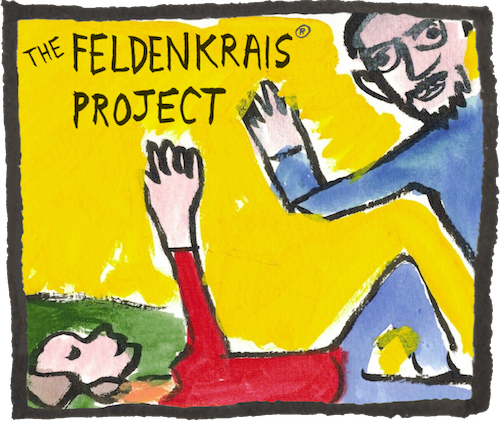Essence for “Experts”: Flexors and Extensors from the Hips and Waist (33m, Patrons)
Prerequisite: You should be familiar with Coordinating Flexors and Extensors (Patrons) or Simple Twisting before doing this version. Learn more about Essence for “Experts” lessons in the lesson notes tabs below.
A distillation of Moshe Feldenkrais's classic Coordinating the Flexors and Extensors lesson. Great for review and for finding a more specific understanding of the role of the hip joints and waistline muscles as conductors of turning actions. When we listen deeply to Moshe and ourselves, we learn that tipping triangle arms and crossed legs further and further is not the point of this famous lesson. The most profound benefits for spinal health, posture, and gait are hidden in the details.
We offer over 50 free lessons, but this one's just for our Patron-level donors. You can learn about it in the free lesson notes and comments below, but to access the audio you’ll need to join The FP as a Patron. Learn more
Donor Tip: Skip this login next time! See Why & How to Stay Logged In (and why it's safe)
Got a question for Nick, or a thought about this lesson?
Use the comments section below! Public comments build our community and help search engines find us.




Nick,
You have an uncanny knack for sharing a lesson that speaks directly to what my ever- evolving body needs at the moment. 2 years ago, an “ancient” adhesion that had glued my small intestine to the abdominal wall was surgically removed. Prior to that, I practiced Feldenkrais (one-on-one as well as your ATM lessons) to bring awareness to deep sensations and reduce tension and pain throughout my body.
Post-surgery, Feldenkrais has been equally critical as I have regained movement that had been restricted by this 50-year-old adhesion. Recently a Fascial Counterstrain therapist released restrictions all around the Mesentery Root (fascial restrictions that likely protected my intestine during all this) and my body is attempting to learn so much more, now that my abdomen moves more freely. The pelvis, the long belly, the hip extensors and flexors are just starting to “coordinate.”
So when this morning’s email included the Essence for “Experts”: Flexors and Extensors from the Hips and Waist, I knew that you shared it for me! All I can say is, Wow! And, thank you!
Love these moments of synchronicity, and glad to be helpful to you! This topic has been really consuming me lately. I’m working slowly toward a new Deep Dive incorporating all the Long Belly, Strong Back material, this lesson, and a few more like it. Stay tuned!
This lesson is really deep. No, I mean really DEEP. Anatomically, that is.
Reviewing the three-dimensional anatomy of the obliques and psoas was helpful to me for this lesson because I had lost sensation/awareness of their functional movements as needed for this lesson. Hip flexion via the psoas is often beyond my awareness, and the coordination of the obliques across the midline is not easy for me. I’m going to have to take this one to the woodshed to study it.
On a related note, I’m fascinated by Jody’s journey toward the discovery of mesenteric adhesions. To what extent was this confirmed anatomically or surgically? was confirmation via medical imaging involved Etc.
Nick, Can you please facilitate communication. I’m hesitant to reveal my identity in the public space because of the sensitive nature of my work, so can you please give Jody my email or phone number for direct communication so we might talk privately. Thanks!
I love it when a lesson gives me the feeling you articulate so well: “I’m going to have to take this one to the woodshed to study it.” Enjoy diving deep! I too find it really interesting in this lesson to study movement function with such muscular specificity in mind. As long as we’re open to the experience of the whole self as we explore, getting clear on anatomical details is a great way to expand the self-image. And, Jody will let you know if she wishes to connect.
I understand. The muscle specificity does not do justice to the sensations//full body awareness. For the sake of discussion, let me further clarify.
Nick’s explanation during the lesson of moving the pelvis downward (toward the feet, from the recumbent position) was informative but initially perplexing (in a good way), until I realized that the only way to do this was to “pull” (without pulling) from the insertion of the psoas (or whatever) to flex the hip, or at least in that direction. Now that I’ve lost everyone, all I’m saying is that this insight allowed me to start moving in a nonhabitual way to coordinate a series of movements that might otherwise not have occurred. As Nick often says during lessons, the purpose of the ATM is not to achieve the movement…
This reminds me of a discussion I had with a different Feldenkrais instructor several years back. The discussion revolved around the title “Awareness Through Movement.” The questions was: Might it be better named “Movement Through Awareness”? Was the title intentionally ambiguous? Was the title an imperfect translation from the Hebrew to English? Etc. After learning from this lesson, I am now of the mind that Moshe’s title is probably intentional. I say this because, if you can’t feel the movement, you can’t feel the awareness. So, it is awareness through movement and not the other way around. Perhaps I read too much into this.
In any event, it’s a great lesson. Thanks Nick!